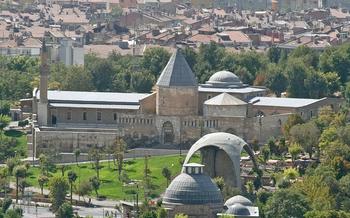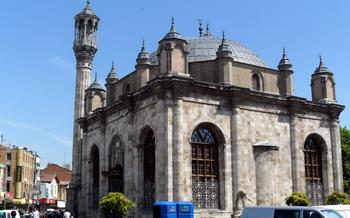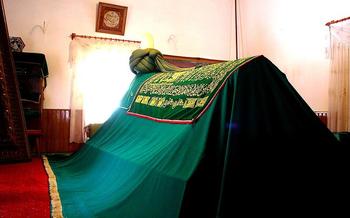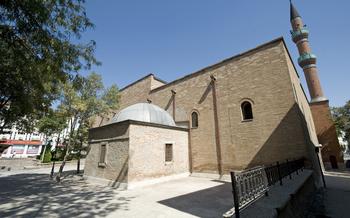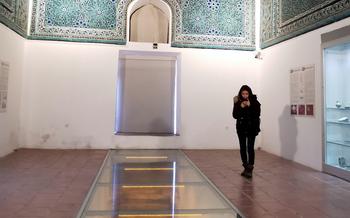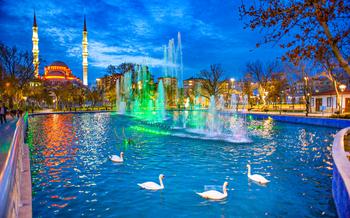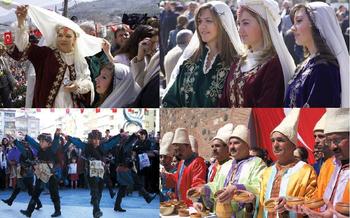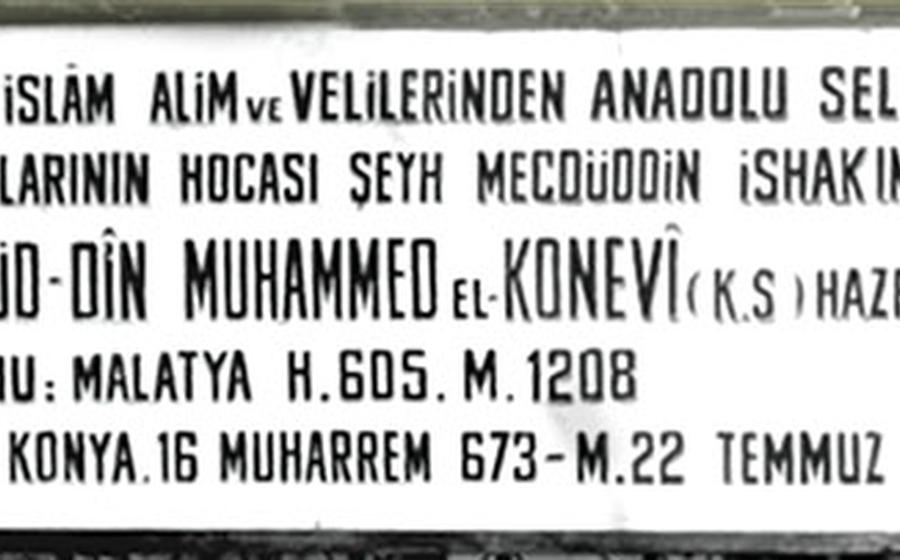
Sadr al Din al Qunawi's Tomb
- Sadr al Din al Qunawi's Tomb: A Mystical Haven
- Journey to Konya: Unveiling Rumi's Legacy
- Exploring the Tomb's Environs: A Mystical Odyssey
- Stepping into the Tomb: Unveiling Mystic Grandeur
- Qunawi's Legacy: Unveiling the Sufi Master
- Abode of Spiritual Enlightenment: The Tomb's Ambiance
- The Art of Illumination: Embracing Qunawi's Manuscripts
- The Whirling Dervishes: A Mesmerizing Spectacle
- Konya's Culinary Delights: A Feast for the Senses
- A Stroll Through History: Exploring Konya's Old Town
- Beyond the Tomb: Unveiling Konya's Hidden Gems
- Practical Tips for a Memorable Visit
- Capturing the Essence: A Photographer's Paradise
- Insider Tip: Unveiling the Tomb's Hidden Treasures
Sadr al Din al Qunawi's Tomb: A Mystical Haven
Sadr al Din al Qunawi's Tomb stands as a testament to the profound impact of Islamic mysticism on the cultural and spiritual landscape of Turkey. Unveiling the life and teachings of the revered Sufi master, Sadr al Din al Qunawi, this sacred site invites visitors to delve into the depths of Islamic spirituality and explore the unique fusion of philosophy, theology, and mysticism that characterized Qunawi's teachings.
History: Unveiling the Life and Teachings of Sadr al Din al Qunawi
Born in 1207 in Persia, Sadr al Din al Qunawi emerged as one of the most influential figures in the history of Sufism. As a disciple of the renowned mystic Ibn Arabi, Qunawi inherited a rich legacy of spiritual knowledge and wisdom. His teachings, deeply rooted in the mystical traditions of Islam, emphasized the significance of love, unity, and the direct experience of the divine. Qunawi's profound insights into the nature of reality and the human soul continue to resonate with seekers of spiritual truth to this day.
Architecture: Exploring the Unique Design and Symbolism of the Tomb
Sadr al Din al Qunawi's Tomb, constructed in the 13th century, reflects the architectural style prevalent during the Seljuk era. Its intricate carvings and decorative elements showcase the artistry and craftsmanship of the period. The tomb's octagonal shape holds symbolic significance, representing the eight stages of the Sufi path or the eight gates of Paradise. The interior of the tomb features a domed ceiling adorned with exquisite calligraphy, invoking a sense of awe and reverence.
Significance: Understanding the Tomb's Importance in Islamic Mysticism
Sadr al Din al Qunawi's Tomb holds immense significance in the realm of Islamic mysticism. As the resting place of one of the most revered Sufi masters, it attracts pilgrims and spiritual seekers from around the world. The tomb serves as a center for contemplation, reflection, and spiritual growth, inviting visitors to connect with the legacy of Qunawi and explore the depths of their own spiritual potential.
Journey to Konya: Unveiling Rumi's Legacy
Location: Konya's significance as the heart of Mevlana Rumi's influence
Konya, a city nestled in the heart of Turkey's Anatolian region, holds a profound significance in the realm of Islamic mysticism. It is here that the renowned Sufi poet and mystic, Mevlana Rumi, found his spiritual home and established a legacy that continues to captivate hearts and minds to this day. Konya, with its rich cultural heritage and vibrant Islamic traditions, serves as a pilgrimage site for those seeking spiritual enlightenment and a deeper understanding of Rumi's teachings.
Transportation: Navigating to Konya from major cities
Reaching Konya is a breeze, with the city boasting excellent transportation links to major cities in Turkey and beyond. Whether you choose to travel by air, rail, or road, you'll find a convenient and comfortable journey to this mystical haven. Konya's airport, Konya Airport, offers direct flights from several domestic and international destinations, making it easily accessible for visitors from around the world. Alternatively, you can embark on a scenic train ride from Istanbul or Ankara, immersing yourself in the captivating landscapes of Turkey's interior. If you prefer a road trip, Konya is well-connected by a network of highways, allowing you to explore the region's natural beauty at your own pace.
Exploring the Tomb's Environs: A Mystical Odyssey
Beyond the tomb itself, Konya offers a plethora of mystical experiences that delve deeper into the legacy of Rumi and the Sufi tradition. The Mevlana Museum, a short walk from the tomb, provides an immersive journey into Rumi's life and teachings, showcasing his manuscripts, personal belongings, and a replica of his living quarters.
Every Saturday, the museum hosts the mesmerizing Sema Ceremony, where Sufi whirling dervishes perform their iconic ritual dance. This enchanting spectacle symbolizes the dervishes' spiritual journey, as they spin in unison, embodying Rumi's message of love, unity, and surrender.
For a glimpse into Konya's rich architectural heritage, visit the Alaeddin Mosque, the city's oldest mosque and a testament to the Seljuk dynasty's grandeur. Admire its intricate tilework, soaring minarets, and the peaceful ambiance that invites contemplation and serenity. Konya's diverse spiritual tapestry is waiting to be explored, offering a mystical odyssey that will leave an enduring impression on every traveler.
Stepping into the Tomb: Unveiling Mystic Grandeur
As you step through the entrance of Sadr al Din al Qunawi's Tomb, a profound sense of reverence and awe washes over you. The air is still and silent, as if time itself has paused to honor the memory of the great Sufi master. The walls, adorned with intricate calligraphy and vibrant tilework, seem to whisper tales of Qunawi's teachings and the profound impact he had on Islamic mysticism.
The tomb's architecture is a testament to the reverence and respect held for Qunawi. The octagonal design, with its eight sides representing the eight gates of paradise, symbolizes the spiritual journey that Qunawi undertook and the enlightenment he achieved. The dome, adorned with intricate geometric patterns, represents the celestial realm, reminding visitors of the ultimate goal of the Sufi path: union with the divine.
The tomb's interior is a symphony of light and shadow, with natural light filtering through the stained-glass windows, casting a warm glow on the walls and illuminating the intricate details of the architecture. The soft light creates an ethereal atmosphere, inviting visitors to contemplate the profound teachings of Qunawi and the transformative power of Sufism.
As you stand in the center of the tomb, gazing upon the sarcophagus where Qunawi's remains lie, a sense of tranquility and peace envelops you. It is as if the tomb itself exudes the spiritual energy that Qunawi embodied throughout his life. Here, in this sacred space, you can connect with the legacy of a great Sufi master and experience the transformative power of his teachings.
Qunawi's Legacy: Unveiling the Sufi Master
Sadr al Din al Qunawi's teachings have left an indelible mark on Islamic mysticism and scholarship. A prolific writer and philosopher, Qunawi delved into the depths of Islamic philosophy and theology, weaving together intricate concepts with remarkable clarity. His magnum opus, "The Wisdom of the Throne" (Hikmat al-Arsh), is considered a masterpiece of Islamic thought, exploring the profound wisdom and symbolism embedded within the divine throne.
Qunawi's mystical insights extended beyond mere intellectual pursuits; he was a practicing Sufi, embodying the principles of love, devotion, and spiritual transcendence. His teachings emphasized the importance of self-purification, inner transformation, and direct experience of the divine. Through his writings and spiritual guidance, Qunawi inspired generations of seekers, guiding them on their mystical journeys towards spiritual enlightenment.
His unique synthesis of philosophy and mysticism earned him a revered position among Sufi masters. Qunawi's teachings continue to influence Islamic thought and practice, serving as a beacon of guidance for those seeking to understand the depths of Sufism and the profound wisdom of the Islamic tradition.
Abode of Spiritual Enlightenment: The Tomb's Ambiance
As you step inside Sadr al Din al Qunawi's Tomb, a profound sense of tranquility and serenity engulfs you. The air is still and silent, broken only by the gentle murmurings of visitors' hushed whispers. The soft glow of natural light filtering through the stained-glass windows casts an ethereal glow upon the tomb's interior, creating an atmosphere of mystical reverence.
The tomb's walls are adorned with intricate carvings and calligraphy, each stroke imbued with spiritual significance. The verses from the Quran and the sayings of Sufi masters dance across the walls, inviting visitors to contemplate the deeper meanings of life and existence. The scent of incense fills the air, adding to the mystical ambiance, while the faint melodies of Sufi music seem to emanate from the very walls, creating a truly immersive experience for visitors.
In the center of the tomb lies the sarcophagus of Sadr al Din al Qunawi, draped in a rich velvet cloth embroidered with golden threads. The sarcophagus is surrounded by a low wooden fence, creating a sense of intimacy and reverence. Visitors often gather around the sarcophagus, offering prayers, reciting verses from the Quran, or simply sitting in silent contemplation, seeking solace and spiritual guidance from the Sufi master.
Whether you are a devout follower of Sufism or simply a curious traveler seeking a glimpse into the mystical world of Islamic spirituality, Sadr al Din al Qunawi's Tomb offers a unique and profound experience. It is a place where the boundaries between the physical and spiritual realms seem to blur, and where visitors can find a sanctuary for contemplation, reflection, and spiritual connection.
The Art of Illumination: Embracing Qunawi's Manuscripts
Sadr al Din al Qunawi's legacy extends beyond his teachings and philosophy to encompass the art of illumination. His manuscripts, adorned with exquisite calligraphy and intricate artwork, stand as testaments to his creative genius and spiritual insights. The calligraphy in Qunawi's manuscripts is a testament to his mastery of the written word. Each letter is meticulously crafted, with flowing lines and elegant curves that create a harmonious rhythm on the page. The vibrant colors used in the illumination further enhance the visual appeal of the manuscripts, drawing the reader's eye to the text and enhancing its meaning.
Qunawi's manuscripts are not merely beautiful objects; they are also vessels of knowledge and wisdom. Through his writings, Qunawi sought to illuminate the path to spiritual enlightenment, guiding his readers towards a deeper understanding of the divine. His manuscripts contain profound insights into Islamic mysticism, philosophy, and theology, offering a glimpse into the mind of one of the most influential Islamic scholars of his time.
The Whirling Dervishes: A Mesmerizing Spectacle
Witness the captivating Sema ceremony, a mesmerizing performance by Sufi whirling dervishes, at the Mevlana Cultural Center in Konya. This ritualistic dance, deeply rooted in Sufism, is a form of spiritual expression and devotion. As the dervishes gracefully twirl in their iconic white robes and conical hats, they symbolize the journey of the soul towards enlightenment. The rhythmic chanting and music create a trance-like atmosphere, allowing the dervishes to transcend the physical realm and connect with the divine. The Sema ceremony is not only a performance but also a spiritual experience that offers a glimpse into the mystical traditions of Sufism.
History of the Sema Ceremony: The Sema ceremony originated in the 13th century under the guidance of Mevlana Rumi, the founder of the Mevlevi Order of Sufis. Rumi himself was a renowned poet and mystic who believed in expressing devotion through music and dance. The Sema ceremony, therefore, became a way for his followers to connect with the divine through movement and rhythm. Over the centuries, the ceremony evolved into a refined and standardized form, becoming an integral part of Mevlevi culture.
Konya's Culinary Delights: A Feast for the Senses
Konya's culinary scene is a captivating blend of traditional Anatolian flavors and modern gastronomic delights. As you explore the city, tantalize your taste buds with an array of mouthwatering dishes that showcase the region's rich culinary heritage.
Indulge in the flavors of etli ekmek, a traditional Turkish flatbread topped with succulent minced meat and aromatic spices. Savor the succulent Konya kebabı, tender lamb grilled to perfection and served with a flavorful tomato sauce. For a vegetarian delight, try fırın sütlac, a creamy rice pudding baked to golden perfection.
Konya's culinary journey doesn't end there. Discover the delectable mevlana şekerlemesi, a sweet treat made with pistachios and rose water, a tribute to the city's spiritual legacy. And don't miss the Konya pidesi, a savory flatbread topped with a variety of fillings, a perfect snack to enjoy on the go.
To fully immerse yourself in Konya's culinary delights, venture beyond the tourist hotspots and seek out the hidden gems favored by locals. Ask for recommendations from your hotel concierge or join a food tour to uncover the city's culinary secrets.
Whether you're savoring a hearty kebab in a traditional Turkish restaurant or indulging in a delicate dessert at a charming café, Konya's culinary scene promises an unforgettable gastronomic experience.
A Stroll Through History: Exploring Konya's Old Town
Alaeddin Hill:
As you wander through Konya's Old Town, Alaeddin Hill beckons with its rich history and ancient charm. This hilltop citadel once served as the city's heart, housing the remnants of Konya's medieval fortifications. Explore the ruins of the city walls and towers, transporting you back to a time of battles and conquests. The panoramic views from the hilltop offer a breathtaking vista of Konya, with its minarets and domes reaching towards the sky.
Sille:
Nestled amidst the picturesque landscapes just outside Konya, Sille is a captivating neighborhood that has stood the test of time. As you stroll through its cobblestone streets, admire the beautifully preserved Ottoman-era houses, each adorned with intricate carvings and colorful facades. Sille is renowned for its pottery and ceramics, with local artisans showcasing their skills in charming workshops. Take the opportunity to witness the creation of these exquisite pieces and perhaps even try your hand at pottery making.
Beyond the Tomb: Unveiling Konya's Hidden Gems
While Sadr al Din al Qunawi's Tomb stands as a beacon of Islamic mysticism, Konya offers a wealth of other hidden gems waiting to be explored. Step beyond the tomb and immerse yourself in the city's rich history and cultural heritage.
Discover the Ince Minare Museum, showcasing intricate tilework and stunning architecture that transport you back in time. Delve into the history and beauty of the Karatay Madrasah, an Islamic school that once echoed with the teachings of renowned scholars. These hidden gems offer a glimpse into Konya's vibrant past and complement the spiritual journey you'll embark on at Sadr al Din al Qunawi's Tomb.
Practical Tips for a Memorable Visit
Dress Code: Adhering to local customs and religious sensitivities is essential when visiting Sadr al Din al Qunawi's Tomb. Modest attire that covers your shoulders and knees is recommended, particularly for women. Head coverings are not mandatory but are a sign of respect in Islamic culture.
Photography: While capturing the beauty of the tomb through photography is permitted, it is essential to be mindful of the sacred nature of the site. Flash photography is prohibited, and it is crucial to avoid disturbing other visitors or disrupting the spiritual atmosphere of the tomb.
Capturing the Essence: A Photographer's Paradise
Sadr al Din al Qunawi's Tomb is a photographer's paradise, offering a wealth of opportunities to capture stunning images. The intricate tilework, calligraphy, and architecture provide a visually captivating backdrop for your shots. The tomb's serene atmosphere and soft, diffused lighting create an ideal environment for capturing the essence of this sacred space.
To make the most of your photography experience, arrive early in the morning or late in the afternoon to take advantage of the golden hour light. This warm, natural light will enhance the colors and textures of the tomb, resulting in more vibrant and dramatic images.
Experiment with different angles and perspectives to create unique and compelling compositions. Capture the tomb's grandeur by shooting from a low angle, or highlight its intricate details with close-up shots. Don't forget to look for reflections in the tomb's many mirrors, which can add depth and interest to your photographs.
Remember to be respectful of the tomb's sanctity and maintain a quiet and contemplative demeanor while taking photos. This will not only ensure a peaceful atmosphere for other visitors but will also allow you to fully immerse yourself in the tomb's spiritual energy and capture its essence through your lens.
Insider Tip: Unveiling the Tomb's Hidden Treasures
Beyond the main chamber of Sadr al Din al Qunawi's Tomb lies a hidden treasure trove of Islamic history and mysticism. A secret chamber, concealed from the casual visitor, awaits those who seek a deeper connection with the Sufi master's legacy. Within this hidden sanctum, visitors can discover a collection of rare and precious artifacts, including Qunawi's personal manuscripts, intricate calligraphy, and beautifully illuminated Qur'ans.
Unveiling these hidden treasures is a journey through time, allowing visitors to delve into the depths of Qunawi's teachings and the rich history of Islamic mysticism. It is an opportunity to connect with the spirit of the Sufi master and gain a deeper understanding of his profound impact on Islamic thought and spirituality.
To access the secret chamber, visitors should seek guidance from the tomb's custodians. With their knowledge and expertise, visitors can unlock the secrets of this hidden treasure and embark on a journey of discovery that will leave a lasting impression.

